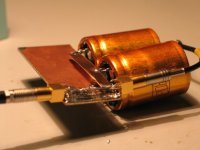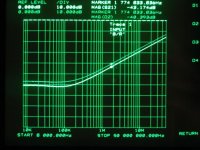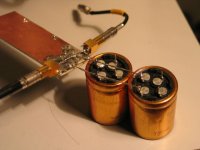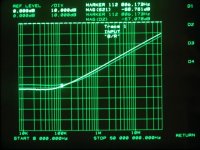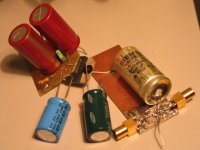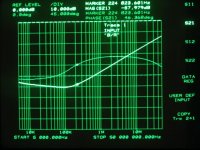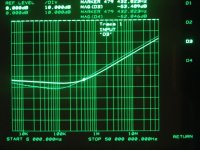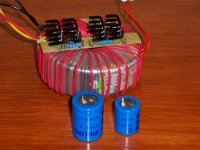Carlos, if you mean 100 nF + 1ohm snubber instead of 680 nF + 1ohm
snubber, my answer is yes, I have tried it as well, the graph is the same, as it is the same with our without..
That pic did not come as sexy like the big Wima, so I put that on the forum!
Now, please, don't take this as an attack! I am not negating your experience (and many other's )! I am only trying to say, that it seems to be not explainable by the net impedance change, as it would be seen by the chip input pin. Because the impedance change, what the snubber effectively causes, ON THE BIG reservoir cap, is attenuated by: the inductance of the wiring between local bypass and big cap,
the local 100 uF bypass cap, which, in fact, is swamping out, partially , also the wiring inductance.
It might mean (if I am right) that it's necessary to search further, not to stop here! For example, the inrush currents. What effect they might cause kicking the tank circuit at the reservoir cap?
snubber, my answer is yes, I have tried it as well, the graph is the same, as it is the same with our without..
That pic did not come as sexy like the big Wima, so I put that on the forum!
Now, please, don't take this as an attack! I am not negating your experience (and many other's )! I am only trying to say, that it seems to be not explainable by the net impedance change, as it would be seen by the chip input pin. Because the impedance change, what the snubber effectively causes, ON THE BIG reservoir cap, is attenuated by: the inductance of the wiring between local bypass and big cap,
the local 100 uF bypass cap, which, in fact, is swamping out, partially , also the wiring inductance.
It might mean (if I am right) that it's necessary to search further, not to stop here! For example, the inrush currents. What effect they might cause kicking the tank circuit at the reservoir cap?
If I could take up some more bandwith, I would like add one other test:
Tube_Dude was asking about paralellling capacitors. Again, I had the same feeling, that it can be guessed, but tried as well.
Here there are two 4700 uF ROE capacitors, paralelled in an "industrial" way:
Tube_Dude was asking about paralellling capacitors. Again, I had the same feeling, that it can be guessed, but tried as well.
Here there are two 4700 uF ROE capacitors, paralelled in an "industrial" way:
Attachments
Joseph K said:That pic did not come as sexy like the big Wima, so I put that on the forum!
Aaaahhhh...😀
Joseph K said:
Tube_Dude was asking about paralellling capacitors. Again, I had the same feeling, that it can be guessed, but tried as well.
Here there are two 4700 uF ROE capacitors, paralelled in an "industrial" way:
Gratzie Joseph
But in the case of two electrolytics in parallel ,we don't see any resonance swing ,as when you put a plastic bypass.
That was to be expected , as when we put a capacitor (the plastic bypass ) across a inductance (the parasitic inductance of the electrolytic ) we always end ,with a resonant circuit.
Ci vediamo
Franz G said:I can hear bats, at least, when more than one is present: the differences of the frequencies are in the audible area.
I suggest that you go to bed every night with a crucifix, clove of garlic and leave the lights on.
"I'm coming master...."
Jorge!
Yes, and this was my point! As you see, here there is an enourmous amount of capacitance lumped to a small (a dozen nanohenry) inductance. The resulting tank circuit is not high Q, and way down on the freq. scale, where it is swamped by the second capacitor itself!
But, never forget, these measurements are very much static, the same way like THD measurements, like spectral analysis, so if there is a little bit of "andarivieni" going on between the two caps.. that one I don't know!
Yes, and this was my point! As you see, here there is an enourmous amount of capacitance lumped to a small (a dozen nanohenry) inductance. The resulting tank circuit is not high Q, and way down on the freq. scale, where it is swamped by the second capacitor itself!
But, never forget, these measurements are very much static, the same way like THD measurements, like spectral analysis, so if there is a little bit of "andarivieni" going on between the two caps.. that one I don't know!
jackinnj said:I suggest that you go to bed every night with a crucifix, clove of garlic and leave the lights on.
"I'm coming master...."
😀 😀 😀
Although Franz explained in his way, I also don't like filters.
I avoid them as much as possible.
It is not really a question of hearing like a bird, it's just that there's usually a (no small) improvement in avoiding a filter or changing a high-order filter for a low-order one.
Not only a matter of frequency responce, really.
Phase...
Joseph K said:But, never forget, these measurements are very much static
Yes, it's not music.😀
Anyway Joseph and Jorge, this last graph is two paralleled electrolythic caps of the same value.
Would a, say, 0.1uf~0.22uf electrolythic be better than a film cap as a bypass across the big cap?
Anyway,
 the good results and the secret, if I can say so, of this PSU is the snubber, and not the bypass cap.
the good results and the secret, if I can say so, of this PSU is the snubber, and not the bypass cap.with that value, you will again have resonance, only that it will be better damped by the 'lythics highis ESR. So it might work. But why would you do that? you don't gain too much, I mean in quality.
I would try to dampen the resonance, caused by a good film cap, by an external resistance - as your snubber is doing it!
If You would take a look at that setup, the "better" combo - I have done just that!
Or, use some Black Gates, hm, now I see
By the way, one day I will organize to put one against the good old HP.. But I'm afraid, in advance, that I will see a good cap, like if it were Philips, for example..
In the meantime, once I will dissect my GC with Elna Cerafine, so as to measure it.. but again, I'm afraid that I will see parameters, lets say, a bit worse than average...
ciao e buona notte!
I would try to dampen the resonance, caused by a good film cap, by an external resistance - as your snubber is doing it!
If You would take a look at that setup, the "better" combo - I have done just that!
Or, use some Black Gates, hm, now I see
By the way, one day I will organize to put one against the good old HP.. But I'm afraid, in advance, that I will see a good cap, like if it were Philips, for example..
In the meantime, once I will dissect my GC with Elna Cerafine, so as to measure it.. but again, I'm afraid that I will see parameters, lets say, a bit worse than average...
ciao e buona notte!
Ecco fatto!
Given the fact that it was broken, so I had it here, so I decided to take apart my GC. It has been a time that I was just curious to see that Cerafine..
I made at once some comparison as well, with respect to some brand that I have, like Samsung, then something that I would call noname because I can't pronounce it, and an old Siemens Sikorel.
Given the fact that it was broken, so I had it here, so I decided to take apart my GC. It has been a time that I was just curious to see that Cerafine..
I made at once some comparison as well, with respect to some brand that I have, like Samsung, then something that I would call noname because I can't pronounce it, and an old Siemens Sikorel.
Attachments
Notice that the generic brands all have a bit less ESL, than the ELNA.
ESL depends on the form factor, and in fact, the smaller capacitors are a bit "faster". The old & big Sikorel loses out on this race, but I would still expect good sound from it...
Also, that noname cap & Sikorel are of a less voltage rating, which means higher ESR, usually.
And, at the end of it, all this absullutely does not matter, with respect to their sound!
Ps.: But it might mean something with respect to phase margin of the amp, that is, stability. These caps can provide less than .05 ohm bypass impedance almost up to 1 Mhz! And, in fact, i had stability problems with my clone with that Elna Cerafine! (without bypassing it)
Good night!
ESL depends on the form factor, and in fact, the smaller capacitors are a bit "faster". The old & big Sikorel loses out on this race, but I would still expect good sound from it...
Also, that noname cap & Sikorel are of a less voltage rating, which means higher ESR, usually.
And, at the end of it, all this absullutely does not matter, with respect to their sound!
Ps.: But it might mean something with respect to phase margin of the amp, that is, stability. These caps can provide less than .05 ohm bypass impedance almost up to 1 Mhz! And, in fact, i had stability problems with my clone with that Elna Cerafine! (without bypassing it)
Good night!
Joseph K said:ESL depends on the form factor, and in fact, the smaller capacitors are a bit "faster".
I have remarked the same even with plastic capacitors.
Usually the smaller ones, are faster than the long ones...
At last in capacitors ...Size matters !😉
These caps can provide less than .05 ohm bypass impedance almost up to 1 Mhz!
Yes...but the 100 nF bypass will have ~1,5 Ohms at 1 Mhz..😎
I've just "recicled" this toroid.
I'm in the process of makin' a PSU with this trafo, MBR16100 schottky diodes and 3x4,700uf Philips caps per rail.
The smaller ones are 40V, the bigger ones are 63V.
Either will do (~+/- 31V DC PSU), it's more a matter of space...
Oh, snubbed, of course.😀
I'm in the process of makin' a PSU with this trafo, MBR16100 schottky diodes and 3x4,700uf Philips caps per rail.
The smaller ones are 40V, the bigger ones are 63V.
Either will do (~+/- 31V DC PSU), it's more a matter of space...
Oh, snubbed, of course.😀
Attachments
- Status
- Not open for further replies.
- Home
- Amplifiers
- Chip Amps
- Carlos' snubberized Gainclone Power supply
